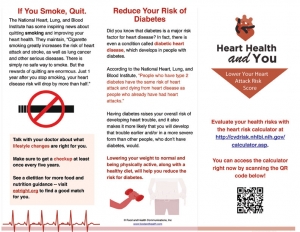Heart Disease Prevention Tips
Heart disease can be a scary thing. The good news is, it's possible to take steps to lower your risk. I'm serious. According to the National Heart, Lung, and Blood Institute (NHLBI), "The main treatment for atherosclerosis is lifestyle changes." Since plaque buildup is at the root of many types of heart disease and health complications (including heart attack and stroke), taking steps to improve your lifestyle could help you reduce your risk of developing it in the first place.Let's take a two-pronged approach to heart disease prevention: diet and exercise.The American Heart Association (AHA) maintains, "A healthy diet is one of the best weapons you have to fight cardiovascular disease. The food you eat (and the amount) can affect other controllable risk factors: cholesterol, blood pressure, diabetes and overweight." The Centers for Disease Control and Prevention (CDC) back up this assertion, stating, "Choosing healthful meal and snack options can help you avoid heart disease and its complications."So, what does a healthful diet look like?
I'm serious. According to the National Heart, Lung, and Blood Institute (NHLBI), "The main treatment for atherosclerosis is lifestyle changes." Since plaque buildup is at the root of many types of heart disease and health complications (including heart attack and stroke), taking steps to improve your lifestyle could help you reduce your risk of developing it in the first place.Let's take a two-pronged approach to heart disease prevention: diet and exercise.The American Heart Association (AHA) maintains, "A healthy diet is one of the best weapons you have to fight cardiovascular disease. The food you eat (and the amount) can affect other controllable risk factors: cholesterol, blood pressure, diabetes and overweight." The Centers for Disease Control and Prevention (CDC) back up this assertion, stating, "Choosing healthful meal and snack options can help you avoid heart disease and its complications."So, what does a healthful diet look like? You can create a personalized diet plan with your doctor or nutritionist, but the broad strokes of a heart-healthy diet are as follows...
You can create a personalized diet plan with your doctor or nutritionist, but the broad strokes of a heart-healthy diet are as follows...
- Lots of fresh fruits and vegetables
- Whole grains
- Low-fat dairy products
- Lean protein
- Moderate amounts of unsaturated fats from foods like fish, nuts, and seeds
- Limited amounts of sodium, saturated fat, added sugars, and refined grains
The NHBLI's TLC diet or DASH diet may also help you prevent heart disease by lowering various heart disease risk factors. Check them out!Remember, making the effort to improve your diet is worth it. "Eating a heart-healthy diet is important for managing your blood pressure and reducing your risk of heart attack, heart disease, stroke and other diseases" (source).Now let's move on to the second realm of lifestyle changes to prevent heart disease: physical activity. The AHA asserts, "Being physically active is also important to prevent heart disease and stroke. Just 40 minutes of aerobic exercise of moderate to vigorous intensity done three to four times a week is enough to lower both cholesterol and high blood pressure."Talk with your doctor about what kinds of physical activity are right for you. Remember, it's wise to start slowly and work steadily. This will help you stick to your new program while reducing your risk of injury.And, to get you thinking about new and fun ways to exercise, consider...
The AHA asserts, "Being physically active is also important to prevent heart disease and stroke. Just 40 minutes of aerobic exercise of moderate to vigorous intensity done three to four times a week is enough to lower both cholesterol and high blood pressure."Talk with your doctor about what kinds of physical activity are right for you. Remember, it's wise to start slowly and work steadily. This will help you stick to your new program while reducing your risk of injury.And, to get you thinking about new and fun ways to exercise, consider...
- Walking with friends or family
- Taking an exercise class
- Trying yoga
- Swimming
- Taking a bike ride
- Going for a jog
Take the CDC's advice and get active! After all, "Physical activity can help you maintain a healthy weight and lower cholesterol and blood pressure." There are other ways to reduce your heart disease risk too. If you smoke, quit. If you're overweight, take steps to manage your weight more effectively. Consider reducing your alcohol intake, and try to find effective ways to deal with stress. All of these could improve your health and lower your risk of heart disease. And remember, "Eating a healthy diet and including exercise in your routine can give you the edge in the fight against heart disease and stroke" (source).References:
There are other ways to reduce your heart disease risk too. If you smoke, quit. If you're overweight, take steps to manage your weight more effectively. Consider reducing your alcohol intake, and try to find effective ways to deal with stress. All of these could improve your health and lower your risk of heart disease. And remember, "Eating a healthy diet and including exercise in your routine can give you the edge in the fight against heart disease and stroke" (source).References:
- How Can Coronary Heart Disease Be Prevented or Delayed? from the NHLBI
- Lifestyle Changes and Cholesterol from the AHA
- Lifestyle Changes for Heart Attack Prevention from the AHA
- Managing Blood Pressure with a Heart-Healthy Diet from the AHA
- Prevention: What You Can Do from the CDC
- What Is Atherosclerosis? from the NHLBI
- Your Guide to Lowering Cholesterol with Therapeutic Lifestyle Changes (TLC) from the NHLBI
- Your Guide to Lowering Your Blood Pressure with DASH from the NHLBI
There are lots of heart disease prevention resources in the Nutrition Education Store, and all of them could help you look your very best, right now!

 Thanks for scrolling! Here's a new handout that covers the basics of reducing heart disease risk...
Thanks for scrolling! Here's a new handout that covers the basics of reducing heart disease risk...


